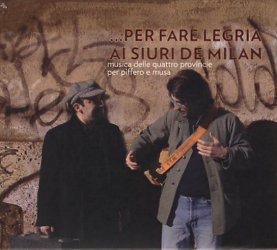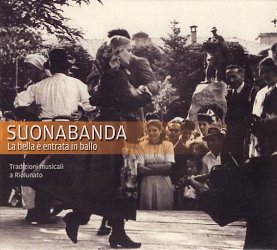| Francesco Nastasi and Andrea Capezzuoli
|
| ... per fare legria ai siuri de Milan
|
| FolkClub Ethnosuoni ES 5386
|
| Suonabanda
|
| La bella è entrata in ballo - The Beauty has Entered into the Dance
|
| FolkClub Ethnosuoni ES 5382
|
ES 5386: 1. Alessandrina in LA maggiore. 2. Monferrina di Napoleone. 3. II Draghino / Sposina. 4. Poica di Ernesto. 5. Valzer triste. 6. Bisagna. 7, 8, 9. Alessandrina in LA minore / Alessandrina in SOL / Vanela / Cache cache. 10. Piana. 11. Balaghidon. 12. Poica in LA minore. 13. Sestrina . 14. I disertori. 15. Gigaa2. 16. Mazurka. 17. Stranot / Perigurdino. 18. Alessandrina in RE. 19. Valzer in DO.
ES 5382: 1. Nella notte dal 30 aprile al primo maggio. 2. Balletto della trippola / Trescone. 3. Ecco il ridente Maggio. 4. Documento originale: il Balletto. 5. Balletto. 6. Scottish. 7. Ambasciata. 8. Documento originale: la Frulana. 9. Frulana. 10. Maggio delle anime purganti. 11. Documento originate: i suonatori. 12. Buonanotte, Polka per mandolino. 13. Eleganza, Mazurka per mandolino. 14. Valzer. 15. Documento originale: la Veneziana. 16. La Veneziana. 17. Polka di Riolunato. 18. Antica Mazurka. 19. Documento originale: la trippola. 20. Documento originale: la fisarmonica. 21. Documento originale: il canto del Maggio.
FolkClub Ethnosuoni is a record label run by Maurizio Martinotti, ex of La Ciapa Rusa. Their extensive output is very mixed, ranging from real traditional music to very modern 'folk' performances. I'm very pleased to say that both these CDs are of the former type. One characteristic of the FCE output is the very high standards of musicianship in evidence, and these two CDs do not disappoint in that respect - although they could hardly be more different.
 Francesco Nastasi and Andrea Capezzuoli play piffero and musa respectively ... the piffero is the northern Italian small folk oboe, like a smaller (and slightly quieter!) bombarde; the musa is the local small bagpipe. The booklet notes go to consderable lengths to explain that, in days long past, these two instruments were the ubiquitous pairing in the area known as i quattro province (the four provinces), the montainous area where the provinces of Genova, Alessandria, Pavia and Piacenza meet (as do the regions of Piemont, Liguria, Lombardia and Emilia Romagna). That was until the accordion came along! Unfortunately, no recordings of piffero and musa playing together exist, so the music on this CD is, necessarily, an imaginitive reconstruction of the style.
Francesco Nastasi and Andrea Capezzuoli play piffero and musa respectively ... the piffero is the northern Italian small folk oboe, like a smaller (and slightly quieter!) bombarde; the musa is the local small bagpipe. The booklet notes go to consderable lengths to explain that, in days long past, these two instruments were the ubiquitous pairing in the area known as i quattro province (the four provinces), the montainous area where the provinces of Genova, Alessandria, Pavia and Piacenza meet (as do the regions of Piemont, Liguria, Lombardia and Emilia Romagna). That was until the accordion came along! Unfortunately, no recordings of piffero and musa playing together exist, so the music on this CD is, necessarily, an imaginitive reconstruction of the style.
Again, the booklet notes explain the problems inherent in this task. Surviving piffero fragments suggest (and old tune notations confirm) that the music was modal in character (mainly B Mixolydian). Obviously, a chromatic accordion can play a modal scale - but choosing appropriate bass chords to go with it is quite another matter - so the later piffero / accordion pairing changed the character of the musical style from its earlier nature. Numerous other difficulties had to be overcome, which are of a mainly technical nature, and need not be elaborated here.
Francesco and Andrea listened to the earliest recorded examples of the quattro province piffero music by 'Jacmòn' Sala (recorded in 1958) and Ernesto Sala (recorded in the 1970s) and tried to create an appropriate musa style to go with it. I think they have been very successful, even if it does sometimes fly in the face of modern piffero style and repertoire.
 You'd like to hear some examples? OK then, let's stick with a couple of tunes you may have heard before:
You'd like to hear some examples? OK then, let's stick with a couple of tunes you may have heard before:  the wonderful Sestrina (sound clip, left) is quite well-known - La Ciapa Rusa recorded it, as did Tiger Moth! Also probably familiar is the Stranot / Perigurdino pairing, which also demonstrates Francesco Nastasi's rather wonderful singing. (sound clip, right)
the wonderful Sestrina (sound clip, left) is quite well-known - La Ciapa Rusa recorded it, as did Tiger Moth! Also probably familiar is the Stranot / Perigurdino pairing, which also demonstrates Francesco Nastasi's rather wonderful singing. (sound clip, right)
 The Suonabanda CD couldn't be more different in sound, though it's just as interesting in its own way. They are a 'revivalist' group which started in 1979 - at about the same time that La Ciapa Rusa, Tre Martelli and several other northern Italian bands began looking for their own traditional music, in the face of the US-centred 'folk boom' - which motivated so many of us in the same way in these islands, a decade earlier. It was not a band I'd heard before I reviewed a previous CD of theirs, and I can't give you too much information about what they did in the past three decades, or how their music has changed/developed/progressed over that period. What I can do is to tell you that they sound like a quartet of musicians with three decades's worth of experience who have decided to avoid
The Suonabanda CD couldn't be more different in sound, though it's just as interesting in its own way. They are a 'revivalist' group which started in 1979 - at about the same time that La Ciapa Rusa, Tre Martelli and several other northern Italian bands began looking for their own traditional music, in the face of the US-centred 'folk boom' - which motivated so many of us in the same way in these islands, a decade earlier. It was not a band I'd heard before I reviewed a previous CD of theirs, and I can't give you too much information about what they did in the past three decades, or how their music has changed/developed/progressed over that period. What I can do is to tell you that they sound like a quartet of musicians with three decades's worth of experience who have decided to avoid  (or abandon?) technical virtuosity, and play the music they love simply and skillfully, in the belief that this is all it needs - and what it deserves. This delightful schottische, Scottish, is a perfect example (sound clip, left). Experienced readers will detect, from this simple phrase, that I really like this CD.
(or abandon?) technical virtuosity, and play the music they love simply and skillfully, in the belief that this is all it needs - and what it deserves. This delightful schottische, Scottish, is a perfect example (sound clip, left). Experienced readers will detect, from this simple phrase, that I really like this CD.
Suonabanda come from Emilia Romagna, the regione that lies at the dividing line between the 'Continental' North and the 'Mediterranean' South of Italy, and this CD features music and songs from the May festivities in Riolunato, southwest of Bologna. The tunes are almost all of the Northern Continental type, and thus do not sound as 'foreign' to British ears as those from the South sometimes do. An unusual aspect of the CD is that, interspersed between the band's tracks are a number of (usually short) field recordings (documenti originali) made during the 1982 festivities including, to finish with, il canto del Maggio delle Ragazze (the Girls' May Song) from 1957. Their inclusion tells us, I think, something about Suonabanda.
 This is a most enjoyable record from a band I like back in 2002, and one I still like in 2011. Here's a bit of the Polka di Riolunato to finish with (sound clip). Very nice! Both CDs are available, as are the rest of the large catalogue, from: www.folkclubethnosuoni.com/html/catalogo_eng.html
This is a most enjoyable record from a band I like back in 2002, and one I still like in 2011. Here's a bit of the Polka di Riolunato to finish with (sound clip). Very nice! Both CDs are available, as are the rest of the large catalogue, from: www.folkclubethnosuoni.com/html/catalogo_eng.html
Rod Stradling - 28.1.11
Site designed and maintained by Musical Traditions Web Services Updated: 28.1.11
 Francesco Nastasi and Andrea Capezzuoli play piffero and musa respectively ... the piffero is the northern Italian small folk oboe, like a smaller (and slightly quieter!) bombarde; the musa is the local small bagpipe. The booklet notes go to consderable lengths to explain that, in days long past, these two instruments were the ubiquitous pairing in the area known as i quattro province (the four provinces), the montainous area where the provinces of Genova, Alessandria, Pavia and Piacenza meet (as do the regions of Piemont, Liguria, Lombardia and Emilia Romagna). That was until the accordion came along! Unfortunately, no recordings of piffero and musa playing together exist, so the music on this CD is, necessarily, an imaginitive reconstruction of the style.
Francesco Nastasi and Andrea Capezzuoli play piffero and musa respectively ... the piffero is the northern Italian small folk oboe, like a smaller (and slightly quieter!) bombarde; the musa is the local small bagpipe. The booklet notes go to consderable lengths to explain that, in days long past, these two instruments were the ubiquitous pairing in the area known as i quattro province (the four provinces), the montainous area where the provinces of Genova, Alessandria, Pavia and Piacenza meet (as do the regions of Piemont, Liguria, Lombardia and Emilia Romagna). That was until the accordion came along! Unfortunately, no recordings of piffero and musa playing together exist, so the music on this CD is, necessarily, an imaginitive reconstruction of the style.
 The Suonabanda CD couldn't be more different in sound, though it's just as interesting in its own way. They are a 'revivalist' group which started in 1979 - at about the same time that La Ciapa Rusa, Tre Martelli and several other northern Italian bands began looking for their own traditional music, in the face of the US-centred 'folk boom' - which motivated so many of us in the same way in these islands, a decade earlier. It was not a band I'd heard before I reviewed a previous CD of theirs, and I can't give you too much information about what they did in the past three decades, or how their music has changed/developed/progressed over that period. What I can do is to tell you that they sound like a quartet of musicians with three decades's worth of experience who have decided to avoid
The Suonabanda CD couldn't be more different in sound, though it's just as interesting in its own way. They are a 'revivalist' group which started in 1979 - at about the same time that La Ciapa Rusa, Tre Martelli and several other northern Italian bands began looking for their own traditional music, in the face of the US-centred 'folk boom' - which motivated so many of us in the same way in these islands, a decade earlier. It was not a band I'd heard before I reviewed a previous CD of theirs, and I can't give you too much information about what they did in the past three decades, or how their music has changed/developed/progressed over that period. What I can do is to tell you that they sound like a quartet of musicians with three decades's worth of experience who have decided to avoid